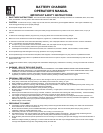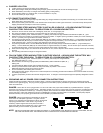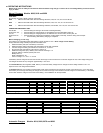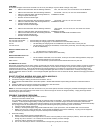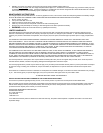4
FEATURES:
All automatic chargers come with an Automatic On-off circuit (12V settings only and a State of charge / Amp-meter.
9014 — SELECT SETTING switch with the following selections; OFF, 10A–12V AUTO, 2A–12V AUTO and 10A–6V MANUAL
9060 — SELECT SETTING switch with the following selections; 55A START, 10A–12V, 2A–12V and 10A–6V MANAUL
— SELECT FUNCTION switch with following selections; CHARGE and START
— Charge Complete Indicator light.
— Reverse connection indicator light.
9070 — SELECT SETTING switch with the following selections; 70A START, 12A–12V, 2A–12V and 12A–6V
— SELECT FUNCTION switch with following selections; CHARGE and START
— Charge Complete Indicator light.
— Reverse connection indicator light.
9090 — SELECT SETTING switch with the following selections; 100A START, 15A–12V AUTO, 2A–12V AUTO and 15A–6V
MANUAL
— SELECT FUNCTION switch with following selections; CHARGE and START
— SELECT BATTERY switch with the following selections; NORMAL/AUTOMOTIVE and DEEP CYCLE
— Charge Complete Indicator light.
— Reverse connection indicator light.
SELECT SETTING switch use:
55A, 70A and 100A START — Use this setting for starting a vehicle with a discharged battery.
10A, 12A and 15A–12V — Use this setting for charging large 12 volt batteries such as Automobiles, boats, etc.
2A–12V — Use this setting for charging small 12 volt batteries such as lawn tractor, motorcycles, etc.
10A and 15A–6V — Use this setting for charging 6 volt batteries, monitor battery continually, since this rating does not taper
or shut off automatically.
SELECT FUNTION switch use:
CHARGE — Use this position to charge a battery.
START — Use this position to start a vehicle with a weak battery.
SELECT BATTERY switch use:
NORMAL/AUTOMOTIVE — Use for standard automobile, truck, lawn tractor, motorcycle and marine starting batteries, Deep cycle
and lead calcium batteries over two years old.
DEEP CYCLE — Use for marine deep cycle and lead calcium batteries less than two years old.
AUTOMATIC On-off Circuit:
With charger in automatic shut-off mode, charger dc output will shut off when correct voltage is reached. Monitor charging a minimum of daily to
ensure that the battery does not over-charge and battery electrolyte is correct. When the charger dc output does shut off, the green "Charge
Complete" light will come on. Power is still supplied to the charger transformer, so a slight hum or buzzing sound is normal as the charger
continues to monitor the battery charge level. If the "Charge Complete" light does not come on at least once in a full day of charging, set the
"SELECT SETTING" switch to "START". If the "Charge Complete" light does not come on within 30 minutes, discontinue charging and have the
battery tested.
BOOST STARTING: MODELS 9050, 9060, 9070 & 9090 ONLY.
! Turn off all lights and accessories in the stalled vehicle.
! Connect the charger to battery per instructions in sections 16 & 17.
! Set the SELECT SETTING switch to the START position. Models 9060 and 9090 require setting the SELECT FUNCTION switch to
START.
! Charge the battery for at least five minutes before attempting to start the vehicle.
! Start the vehicle with the charger connected to the battery.
NOTE: Do not crank the engine more than 20 seconds in any five minute period; excessive cranking may overheat and damage the starter. If
the vehicle fails to start, while waiting for the starter to cool, allow the charger to continue to charge the battery. Unplug the charger before
disconnecting dc clips from battery.
POSSIBLE CHARGING PROBLEMS:
1. ! Meter needle swings to far right side of meter: (Manual).
! Reverse connection indicator is On.
Your new battery charger has been equipped with an automatic reset circuit breaker. This protects the charger from temporary overload
conditions. A severely discharged battery, a battery with shorted cells, or reversed charger connections at the battery will cause this
protective device to operate. Under these overload conditions, the circuit breaker will open, and when cooled down will reset automatically.
This cycling process can be identified by a clicking sound made during the opening and closing of the circuit breaker.
a. Check for reverse polarity connections.
b. If battery is severely discharged, charge meter needle will start to cycle up and down, and will stabilize after 15 to 20 minutes.
c. Battery may have one or more shorted cells. Cycling will start immediately and continue indefinitely. If cycling has not stopped as
outlined in (b), disconnect charger (AC power cord first) and have battery tested.
2. ! No meter reading:
a. Battery is fully charged (charge complete light is on).
b. Check connections to battery and engine block or car frame. Be sure polarity is correct (red clip to positive). "Rock" the clips to bite
through any dirt or corrosion. If in a vehicle, be sure terminal on battery are clean and tight.
c. Check AC outlet or extension cord connections.
d. One or more cells may be shorted. Thermal switch in charger may cycle (click on and off).



